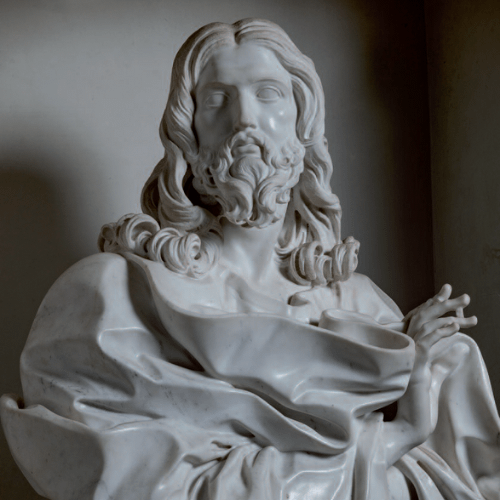The rediscovered bust of the Salvator Mundi by Gian Lorenzo Bernini
The article examines the problem of the last sculpture executed by Bernini in the light of more recent discoveries. The bust of the blessing Christ, or Salvator Mundi, was sculpted by the octogenarian artist in 1679 and on his death (1680) was bequeathed to Queen Christina of Sweden; she left it in turn to Pope Innocent XI Odescalchi, whose family retained the work till the end of the eighteenth century, when all trace of it was lost. Basing themselves on the preparatory drawing preserved in the Istituto Nazionale per la Grafica (F.C. 127528) in Rome, art historians have tried over the last thirty years to trace Bernini’s lost original. Initially (1972) identified in the version now preserved in the Chrysler Museum in Norfolk (Virginia), the bust was subsequently (1999) claimed to be the one in the Cathedral of Sées in Normandy (France). This is of higher quality than the version in the Chrysler Museum, but both the type of marble used and the stylistic characteristics of the Salvator Mundi in Sées show that it is the work of a French sculptor, who freely interpreted the model created by Bernini in a more classical style. Only in 2001, on the occasion of research conducted for the exhibition on the Albani Pope, Clement XI, and the arts (Urbino-Rome), was a bust of the "Saviour" reported in the convent adjacent to the Basilica of San Sebastiano fuori le Mura, hitherto unknown to the literature. This admirable sculpture presents the baroque characteristics peculiar to Bernini’s late style, and fully corresponds to the early descriptions of the bust, both in its dimensions ("half figure larger than life size”: "mezza figura maggiore del naturale") and in the material of the pedestal, in Sicilian jasper. It can therefore be considered Bernini’s original, for so long hunted in vain. As for its provenance, even if the documentation on the Basilica of San Sebastiano from the nineteenth century to the present day is fragmentary, it is certain that before 1960 the bust was situated in the sacristy of the Albani Chapel and not in the convent. An important piece of documentary evidence suggesting why it may have ended up there is provided by an inventory of the Palazzo Albani in Rome dating to c. 1851, which cites a bust of Saviour, which in terms of size and material seems to be that of Bernini. The close kinship ties between the Roman papal families could explain the transfer of the bust from the Palazzo Odescalchi to the Palazzo Albani. In this case, it would have been the heirs of the Albani family, whose last descendent died in 1852, who destined the bust to the sacristy of the funerary chapel of the family in San Sebastiano fuori le Mura, where it remained until being removed to the adjoining convent.
FRANCESCO PETRUCCI: IL RITROVATO BUSTO DEL SALVATORE DI GIAN LORENZO BERNINI (ESTRATTO DAL FASC. 124 bollettino d'Arte)
